Water Accounting Using Satellite Products and Water Accounting Plus Framework in a Semi-Arid Betwa River Basin, India
Abstract
:1. Introduction
2. Study Area Description
2.1. Location
2.2. Geology, Soil Types, and Climate
3. Modeling
3.1. Satellte Products
3.2. WA+ Modeling
4. Results and Discussion
4.1. Generation of WA+ Based LULC Map (WALU-Water Accounting and Land Use)
4.2. Spatio-Temporal Distribution of Rainfall
Validation of PERSIANN and CHIRPS with the IMD datasets
4.3. Spatio-Temporal Variability of Evapotranspiration and Water Yield in the Basin
4.4. Estimation of Total Water Consumption in the Basin (Sheet 2)
5. Conclusions
Author Contributions
Funding
Data Availability Statement
Acknowledgments
Conflicts of Interest
Appendix A
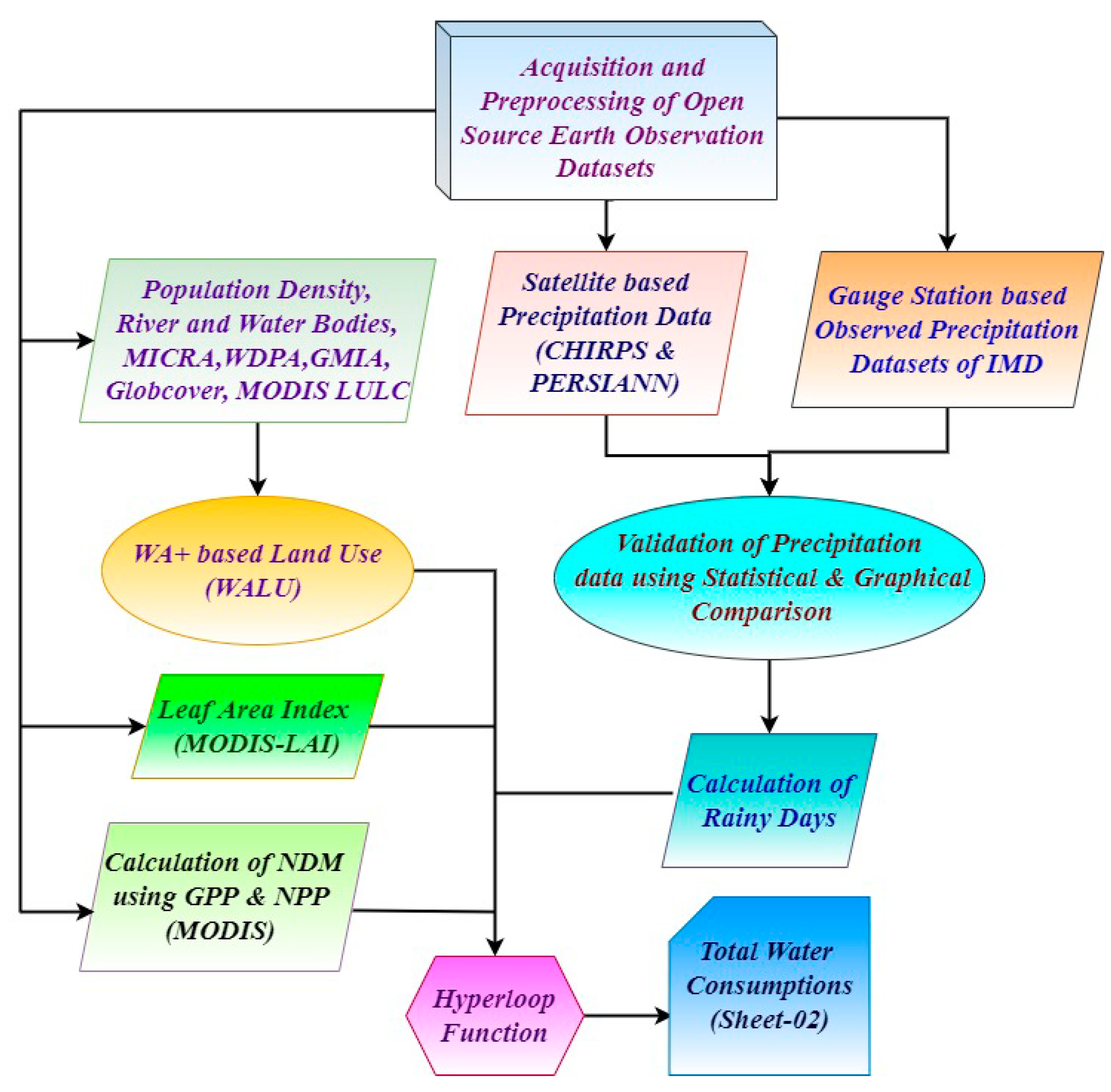
References
- World Water Assessment Programme (Nations Unies). The United Nations World Water Development Report 2018; United Nations Educational, Scientific and Cultural Organization: New York, NY, USA, 2018; Available online: www.unwater.org/publications/world-water-development-report-2018/ (accessed on 12 March 2022).
- Wada, Y.; Flörke, M.; Hanasaki, N.; Eisner, S.; Fischer, G.; Tramberend, S.; Satoh, Y.; van Vliet, M.T.H.; Yillia, P.; Ringler, C.; et al. Modelling global water use for the 21st century: The Water Futures and Solutions (WFaS) initiative and its approaches. Geosci. Model Dev. 2016, 9, 175–222. [Google Scholar] [CrossRef] [Green Version]
- IPCC. 2022: Climate Change 2022: Impacts, Adaptation, and Vulnerability. Contribution of Working Group II to the Sixth Assessment Report of the Intergovernmental Panel on Climate Change; Pörtner, H.-O., Roberts, D.C., Tignor, M., Poloczanska, E.S., Mintenbeck, K., Alegría, A., Craig, M., Langsdorf, S., Löschke, S., Möller, V., et al., Eds.; Cambridge University Press: Cambridge, UK, 2022; Available online: https://www.ipcc.ch/report/ar6/wg2/downloads/report/IPCC_AR6_WGII_FinalDraft_FullReport.pdf (accessed on 14 March 2022).
- Deng, H.; Chen, Y.; Chen, X. Driving factors and changes in components of terrestrial water storage in the endorheric Tibetan Plateau. J. Hydrol. 2022, 612, 128225. [Google Scholar] [CrossRef]
- Moore, I.D.; Grayson, R.B.; Ladson, A.R. Digital terrain modelling: A review of hydrological, geomorphological, and biological applications. Hydrol. Processes 1991, 5, 3–30. [Google Scholar] [CrossRef]
- Molden, D.; Sakthivadivel, R. Water accounting to assess use and productivity of water. Int. J. Water Resour. Dev. 1999, 15, 55–71. [Google Scholar] [CrossRef]
- FAO; IHE Delft. Water Accounting in the Niger River Basin; FAO WaPOR Water Accounting Reports; Food and Agriculture of the United Nations: Rome, Italy, 2020. [Google Scholar]
- Kumar, N.; Singh, S.K. Soil erosion assessment using earth observation data in a trans-boundary river basin. Nat. Hazards. 2021, 107, 1–34. [Google Scholar] [CrossRef]
- National Water Policy, Draft Recommended by National Water Board, Ministry of Water Resources. 2012. Available online: http://mowr.gov.in/writereaddata/linkimages/DraftNWP2012_English9353289094.pdf (accessed on 4 April 2022).
- Kumar, N.; Dubey, A.K.; Goswami, U.P.; Singh, S.K. Modeling of hydrological and environmental flow dynamics over a central Himalayan River basin through satellite altimetry and recent climate projections. Int. J. Climatol. 2022. [Google Scholar] [CrossRef]
- Godfrey, J.M.; Chalmers, K. Water Accounting: International Approaches to Policy and Decision-Making; Edward Elgar Publishing: Camberley, UK, 2012. [Google Scholar]
- Karimi, P.; Molden, D.; Bastiaanssen, W.G.M.; Cai, X. Water Accounting to Assess Use and Productivity of Water: Evolution of a Concept and New Frontiers. In Water Accounting: International Approaches to Policy and Decision-Making; Godfrey, J.M., Chalmers, K., Eds.; Edward Elgar Publishing: Cheltenham, UK, 2012; pp. 76–88. [Google Scholar] [CrossRef]
- Karimi, P.; Bastiaanssen, W.G.M.; Molden, D. Water Accounting Plus (WA+)—A water accounting procedure for complex river basins based on satellite measurements. Hydrol. Earth Syst. Sci. 2013, 17, 2459–2472. [Google Scholar] [CrossRef] [Green Version]
- Molden, D. Accounting for Water Use and Productivity, SWIM Paper 1; International Irrigation Management Institute: Colombo, Sri Lanka, 1997. [Google Scholar]
- Kijne, J.W.; Barker, R.; Molden., D. (Eds.) Water Productivity in Agriculture: Limits and Opportunities for Improvement; (Comprehensive Assessment of Water Management in Agriculture Series 1); CABI: Wallingford, UK; International Water Management Institute (IWMI): Colombo, Sri Lanka, 2003; Volume xix, 332p. [Google Scholar]
- Bastiaanssen, W.G.M.; Chandrapala, L. Water balance variability across Sri Lanka for assessing agricultural and environmental water use. Agric. Water Manag. 2003, 58, 171–192. [Google Scholar] [CrossRef]
- Gosling, S.N.; Arnell, N.W. A global assessment of the impact of climate change on water scarcity. Clim. Chang. 2016, 134, 371–385. [Google Scholar] [CrossRef]
- Shilpakar, R.L.; Bastiaanssen, W.G.M.; Molden, D.J. A remote sensing-based approach for water accounting in the East Rapti River Basin, Nepal. Himal. J. Sci. 2012, 7, 15–30. [Google Scholar] [CrossRef] [Green Version]
- Dost, R.; Obando, E.B.; Bastiaanssen, W.; Hoogeveen, J. Water Accounting Plus (WA+) in the Awash River Basin; Food and Agriculture of the United Nations: Amsterdam, The Netherlands, 2012. [Google Scholar]
- FAO; IHE Delft. Water Accounting in the Nile River Basin; FAO WaPOR Water Accounting Reports; Food and Agriculture of the United Nations: Rome, Italy, 2020. [Google Scholar] [CrossRef]
- Kayatz, B.; Harris, F.; Hillier, J.; Adhya, T.; Dalin, C.; Nayak, D.; Green, R.F.; Smith, P.; Dangour, A.D. “More crop per drop”: Exploring India’s cereal water use since 2005. Sci. Total Environ. 2019, 673, 207–217. [Google Scholar] [CrossRef] [PubMed]
- Luo, T.; Young, R.S.; Reig, P. Aqueduct Projected Water Stress Country Rankings; World Resources Institute: Washington, DC, USA, 2015. [Google Scholar]
- Central Water Commission (CWC). Water and Related Statistics; Directorate of Information System Organisation, Water Planning and Projects Wing Report; Central Water Commission: New Delhi, India, 2015. [Google Scholar]
- Madhok, A.K. Enhancing Water Use Efficiency, Roorkee Water Conclave 2020. 2020. Available online: https://www.iitr.ac.in/rwc2020/pdf/papers/RWC_246_Madhok_A_K.pdf (accessed on 1 April 2022).
- Molden, D.; Oweis, T.Y.; Pasquale, S.; Kijne, J.W.; Hanjra, M.A.; Bindraban, P.S.; Bouman, B.A.M.; Cook, S.; Erenstein, O.; Farahani, H.; et al. Pathways for Increasing Agricultural Water Productivity; Earthscan: London, UK; International Water Management Institute: Colombo, Sri Lanka, 2007; No. 612-2016-40552. [Google Scholar]
- Harsh, J. Micro-Irrigation in India: An Assessment of Bottlenecks and Realities. 2017. Available online: https://globalwaterforum.org/2017/06/13/micro-irrigation-in-india-an-assessment-of-bottlenecks-and-realities/ (accessed on 15 May 2022).
- Sharma, B.R.; Gulati, A.; Mohan, G.; Manchanda, S.; Ray, I.; Amarasinghe, U. Water Productivity Mapping of Major Indian Crops, NABARD and ICRIER. 2018. Available online: https://www.nabard.org/auth/writereaddata/tender/1806181128Water%20Productivity%20Mapping%20of%20Major%20Indian%20Crops,%20Web%20Version%20(Low%20Resolution%20PDF).pdf (accessed on 3 March 2022).
- EnviStats India: Environment Accounts; Annual Report 2020–2021; Department of Agriculture, Cooperation & Farmer’s Welfare: Delhi, India, 2020; Volume II.
- CGWB. National Compilation on Dynamic Groundwater Resources of India, 2017; Central Ground Water Board, Government of India: Delhi, India, 2019. [Google Scholar]
- FAO; IFAD; UNICEF; WFP; WHO. The State of Food Security and Nutrition in the World 2021. In Transforming Food Systems for Food Security, Improved Nutrition and Affordable Healthy Diets for All; FAO: Rome, Italy, 2021. [Google Scholar] [CrossRef]
- Amarasinghe, U.A.; Shah, T.; Turral, H.; Anand, B.K. India’s Water Future To 2025–2050: Business-As-Usual Scenario And Deviations; IWMI Research Reports 44522; International Water Management Institute: Colombo, Sri Lanka, 2007. [Google Scholar]
- Sakthivadivel, R.; Thiruvengadachari, S.; Amerasinghe, U.; Bastiaanssen, W.G.M.; Molden, D. Performance Evaluation of the Bhakra Irrigation System, India, Using Remote Sensing and GIS Techniques; Research Report 28; International Water Management Institute: Colombo, Sri Lanka, 1999. [Google Scholar]
- Singh, P.K.; Jain, S.K.; Mishra, P.K.; Goel, M.K. An assessment of water consumption patterns and land productivity and water productivity using WA+ framework and satellite data inputs. Phys. Chem. Earth Parts A/B/C 2021, 126, 103053. [Google Scholar] [CrossRef]
- Pati, J.K.; Patel, S.C.; Pruseth, K.L.; Malviya, V.P.; Arima, M.; Raju, S.; Pati, P.; Prakash, K. Geology and geochemistry of giant quartz veins from the Bundelkhand Craton, central India and their implications. J. Earth Syst. Sci. 2007, 116, 497–510. [Google Scholar] [CrossRef]
- Malviya, V.P.; Arima, M.; Pati, J.K.; Kaneko, Y. Petrology and geochemistry of metamorphosed basaltic pillow lava and basaltic komatiite in Mauranipur area: Subduction related volcanism in the Archean Bundelkhand craton, Central India. J. Mineral. Petrol. Sci. 2006, 101, 199–217. [Google Scholar] [CrossRef] [Green Version]
- Suryavanshi, N.; Furmston, J.; Ridley, A.J. The STRIPAK complex components FAM40A and FAM40B regulate endothelial cell contractility via ROCKs. BMC Cell Biol. 2018, 19, 26. [Google Scholar] [CrossRef]
- Economic Survey 2018–2019, Economic Division, Department of Economic Affairs, Ministry of Finance, Government of India, New Delhi. 2019. Available online: https://www.thehinducentre.com/resources/article28283454.ece/binary/Economic%20Survey%20Volume%20II%20Complete%20PDF.pdf (accessed on 5 March 2021).
- Ahlawat, O.P.; Gupta, P.; Kumar, S.; Sharma, D.K.; Ahlawat, K. Bioremediation of fungicides by spent mushroom substrate and its associated microflora. Ind. J. Microbio. 2010, 50, 390–395. [Google Scholar] [CrossRef] [Green Version]
- Available online: https://www.wateraccounting.org/ (accessed on 3 January 2022).
- Karimi, P.; Bastiaanssen, W.G.M.; Molden, D. Water Accounting Plus (WA+)—A water accounting procedure for complex river basins based on satellite measurements. Hydrol. Earth Syst. Sci. Discuss. 2012, 9, 12879–12919. [Google Scholar] [CrossRef]
- Karimi, P.; Bastiaanssen, W.G.M.; Molden, D.; Cheema, M.J.M. Basin-wide water accounting based on remote sensing data: An application for the Indus Basin. Hydrol. Earth Syst. Sci. 2013, 17, 2473–2486. [Google Scholar] [CrossRef] [Green Version]
- Delavar, M.; Morid, S.; Morid, R.; Farokhnia, A.; Babaeian, F.; Srinivasan, R.; Karimi, P. Basin-wide water accounting based on modified SWAT model and WA+ framework for better policy making. J. Hydrol. 2020, 585, 124762. [Google Scholar] [CrossRef]
- Lambin, E.F.; Turner, B.L.; Geist, H.J.; Agbola, S.B.; Angelsen, A.; Bruce, J.W.; Coomes, O.T.; Dirzo, R.; Fischer, G.; Folke, C.; et al. The causes of land-use and land-cover change: Moving beyond the myths. Glob. Environ. Chang. 2001, 11, 261–269. [Google Scholar] [CrossRef]
- Available online: https://irain.eng.uci.edu/ (accessed on 2 January 2022).
- Sorooshian, S.; Hsu, K.; Coppola, E.; Tomasseti, B.; Verdecchia, M.; Visconti, G. Hydrological Modelling and the Water Cycle: Coupling the Atmospheric and Hydrological Models; Springer: Berlin/Heidelberg, Germany, 2008. [Google Scholar] [CrossRef]
- Available online: https://climateengine.com/ (accessed on 2 January 2022).
- Available online: https://chrsdata.eng.uci.edu/ (accessed on 2 January 2022).
- Available online: https://rainsphere.eng.uci.edu/ (accessed on 3 January 2022).
- Available online: https://www.watres.com/ (accessed on 3 January 2022).
- Funk, C.; Peterson, P.; Landsfeld, M.; Pedreros, D.; Verdin, J.; Shukla, S.; Husak, G.; Rowland, J.; Harrison, L.; Hoell, A.; et al. The climate hazards group infrared precipitation with stations—A new environmental record for monitoring extremes. Sci. Data 2015, 2, 150066. [Google Scholar] [CrossRef] [PubMed] [Green Version]
- Yan, K.; Park, T.; Yan, G.; Liu, Z.; Yang, B.; Chen, C.; Nemani, R.R.; Knyazikhin, Y.; Myneni, R.B. Evaluation of MODIS LAI/FPAR Product Collection 6. Part 2: Validation and Intercomparison. Remote Sens. 2016, 8, 460. [Google Scholar] [CrossRef] [Green Version]
- Ali, H.; Mishra, V. Increase in Subdaily Precipitation Extremes in India Under 1.5 and 2.0 °C Warming Worlds. Geophys. Res. Lett. 2018, 45, 6972–6982. [Google Scholar] [CrossRef] [Green Version]
- Prakash, A.; Goodrich, C.G.; Singh, S. Informing Water Policies in South Asia; Routledge Publications: Oxford, UK, 2014; p. 252. [Google Scholar]
- Musie, M.; Momblanch, A.; Sen, S. Exploring future global change-induced water imbalances in the Central Rift Valley Basin, Ethiopia. Clim. Chang. 2021, 164, 47. [Google Scholar] [CrossRef]
- Gupta, V.; Singh, V.; Jain, M.K. Assessment of precipitation extremes in India during the 21st century under SSP1-1.9 mitigation scenarios of CMIP6 GCMs. J. Hydrol. 2020, 590, 125422. [Google Scholar] [CrossRef]
- Dembélé, M.; Schaefli, B.; Giesen, N.V.D.; Mariéthoz, G. Suitability of 17 gridded rainfall and temperature datasets for large-scale hydrological modelling in West Africa. Hydrol. Earth Syst. Sci. 2020, 24, 5379–5406. [Google Scholar] [CrossRef]
- Aadhar, S.; Mishra, V. High-resolution near real-time drought monitoring in South Asia. Sci. Data 2017, 4, 170145. [Google Scholar] [CrossRef] [Green Version]
- Senay, G.B.; Kagone, S.; Velpuri, N.M. Operational global actual evapotranspiration: Development, evaluation, and dissemination. Sensors 2020, 20, 1915. [Google Scholar] [CrossRef]
- Al-Bakri, J.T.; D’Urso, G.; Batchelor, C.; Abukhalaf, M.; Alobeiaat, A.; Al-Khreisat, A.; Vallee, D. Remote Sensing-Based Agricultural Water Accounting for the North Jordan Valley. Water 2022, 14, 1198. [Google Scholar] [CrossRef]
- Singh, V.G.; Singh, S.K.; Kumar, N.; Singh, R.P. Simulation of land use/land cover change at a basin scale using satellite data and markov chain model. Geocarto Int. 2022, 1–26. [Google Scholar] [CrossRef]
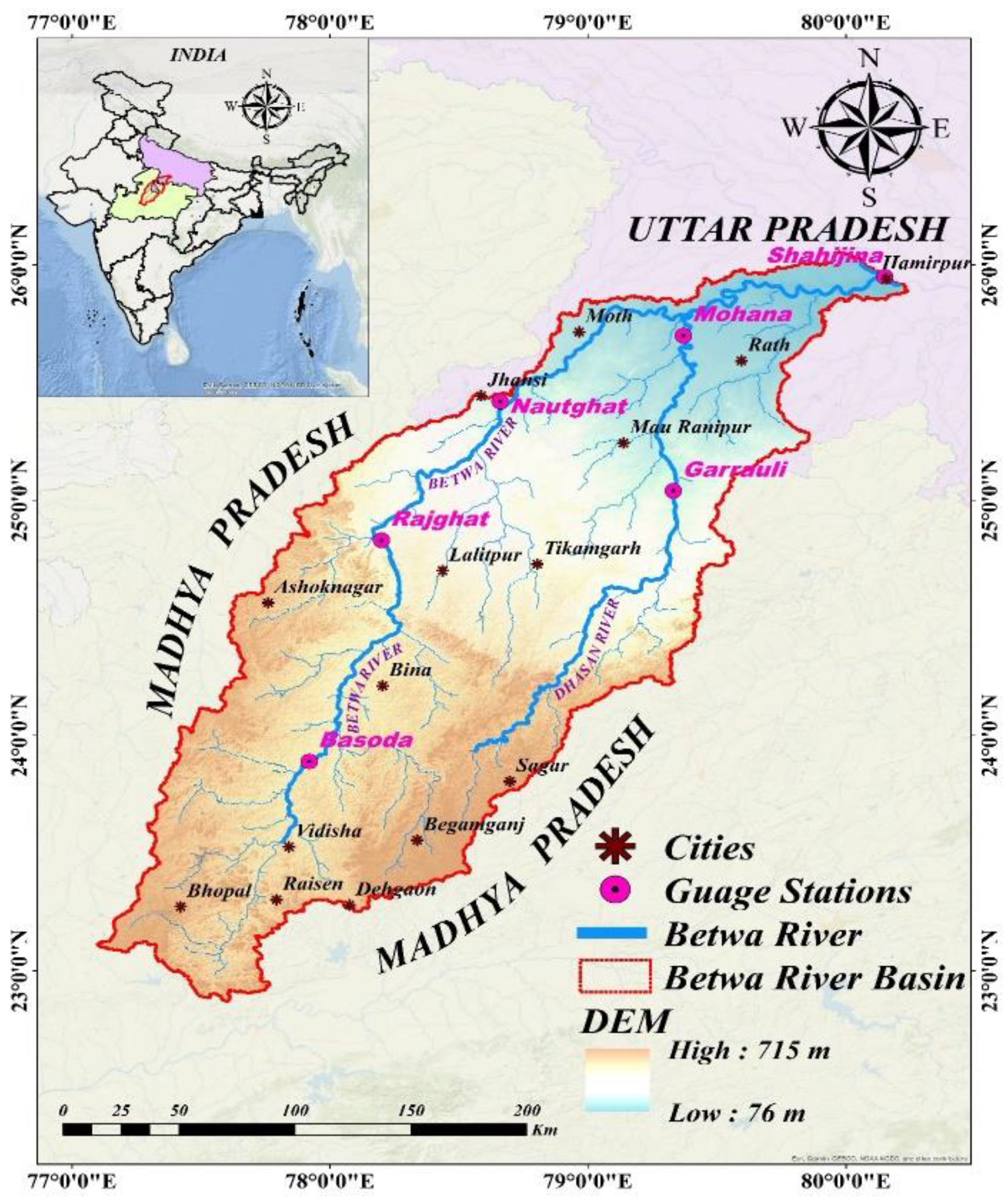
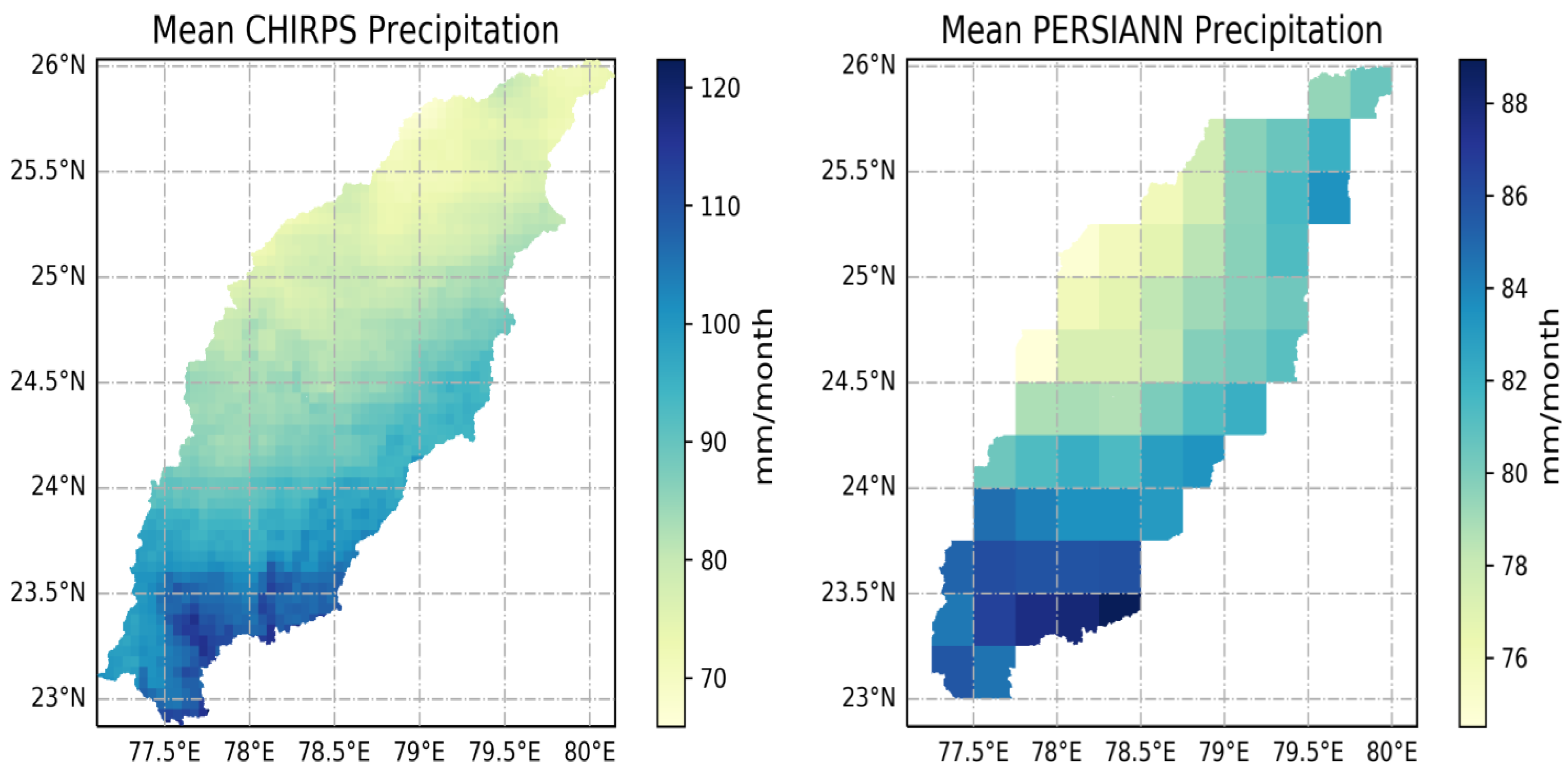
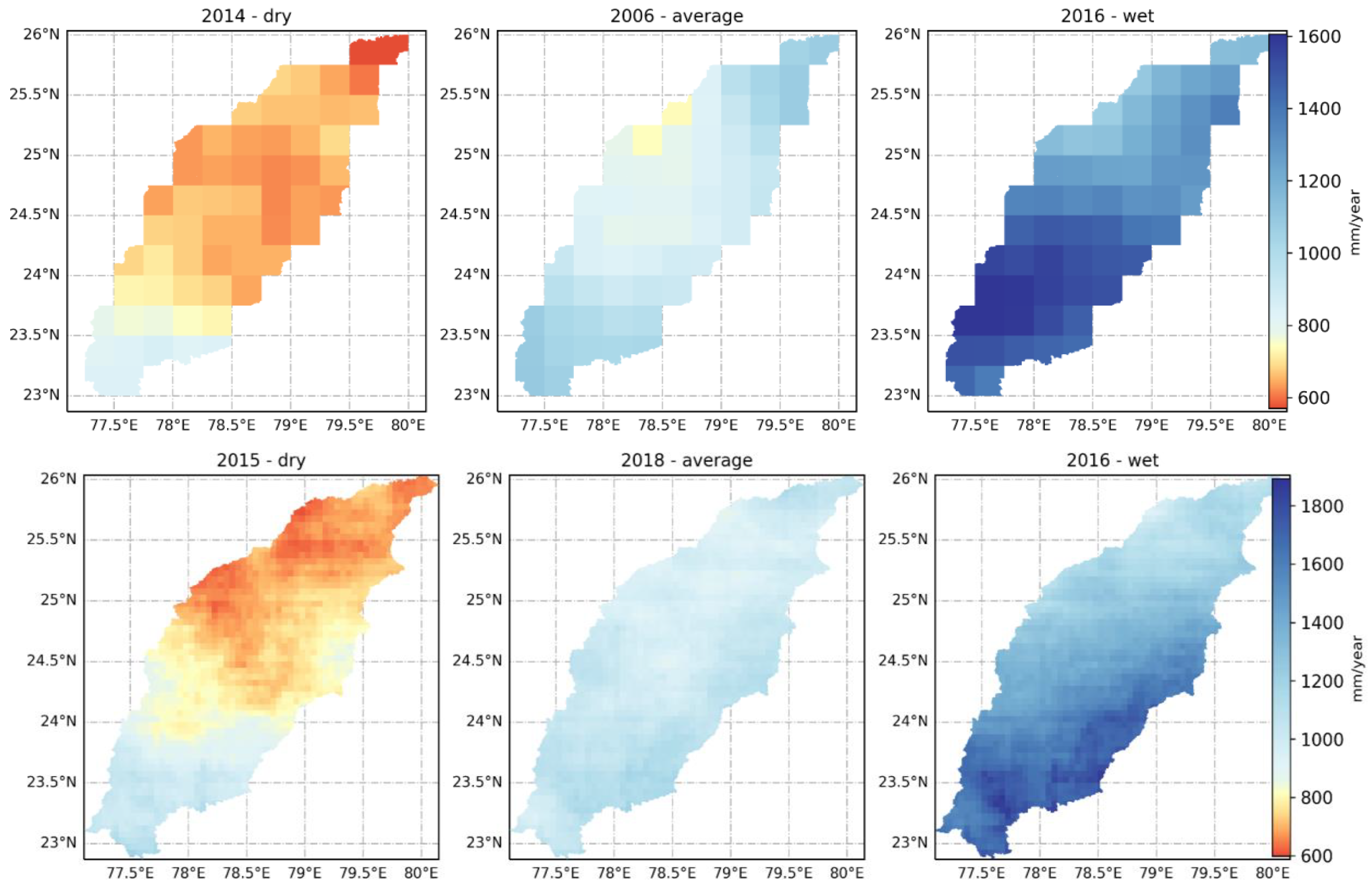

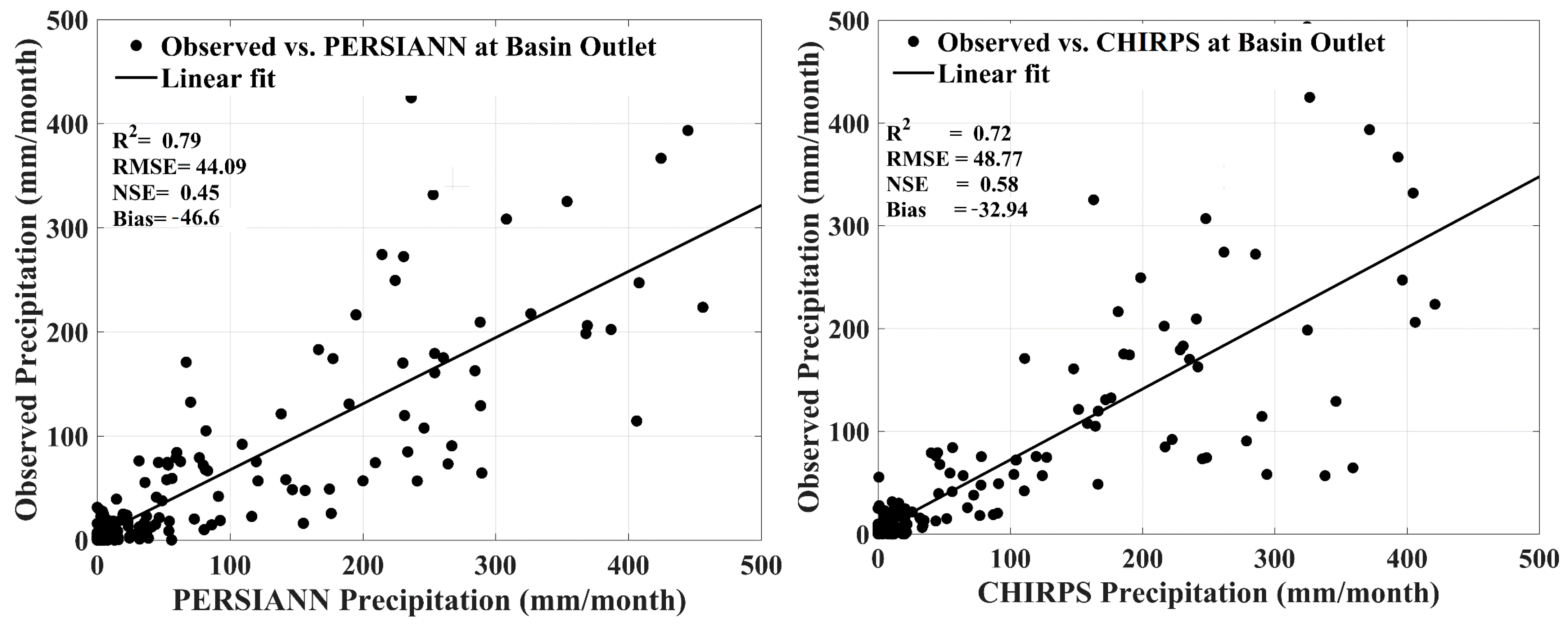
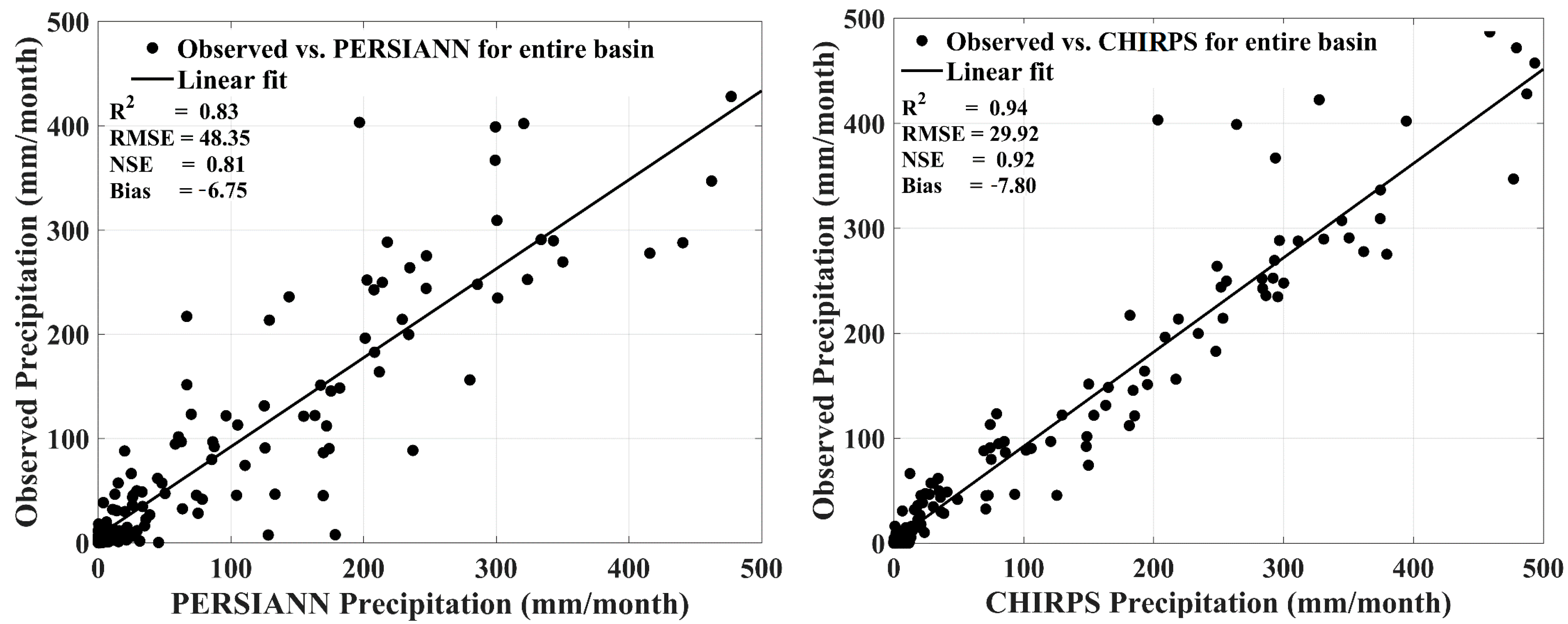
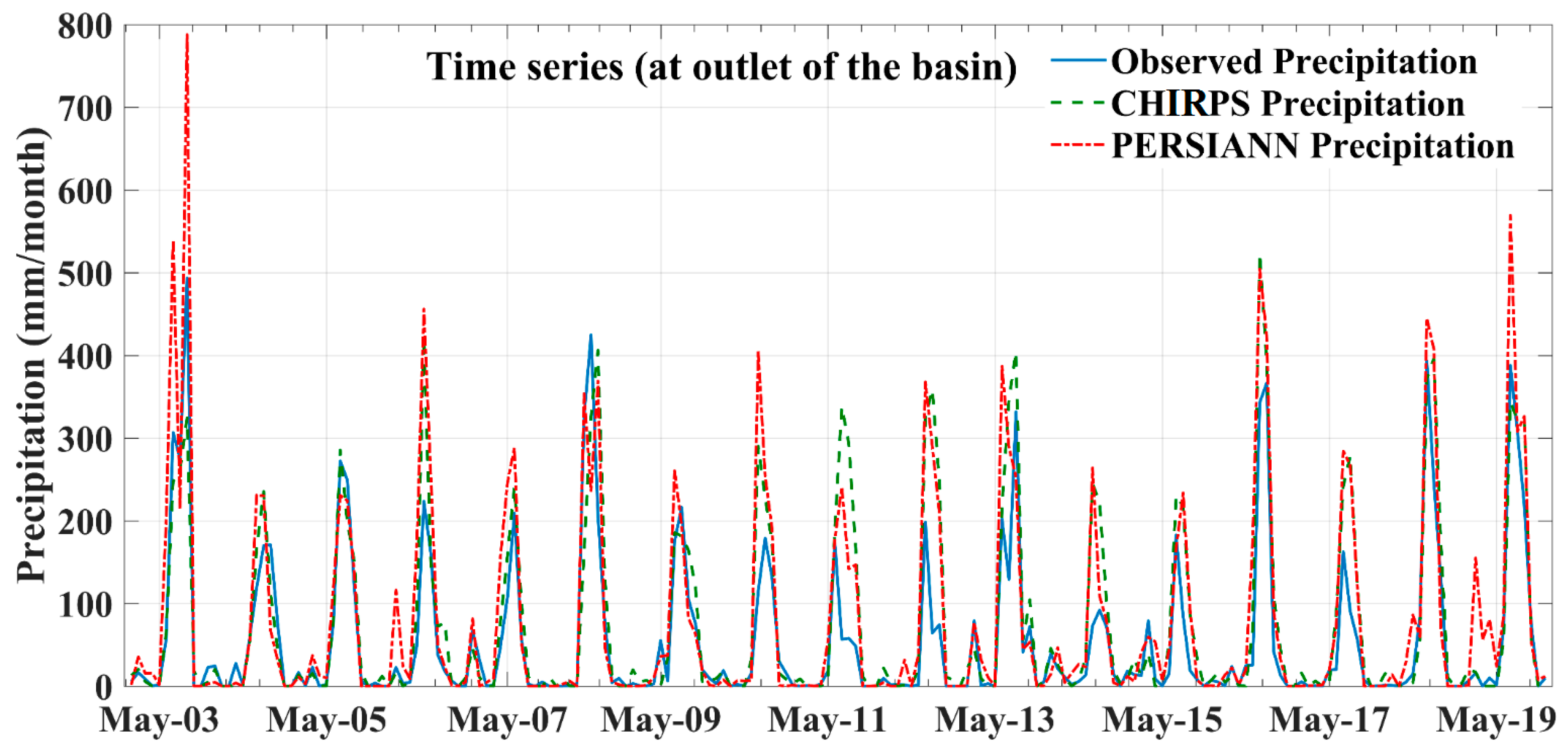
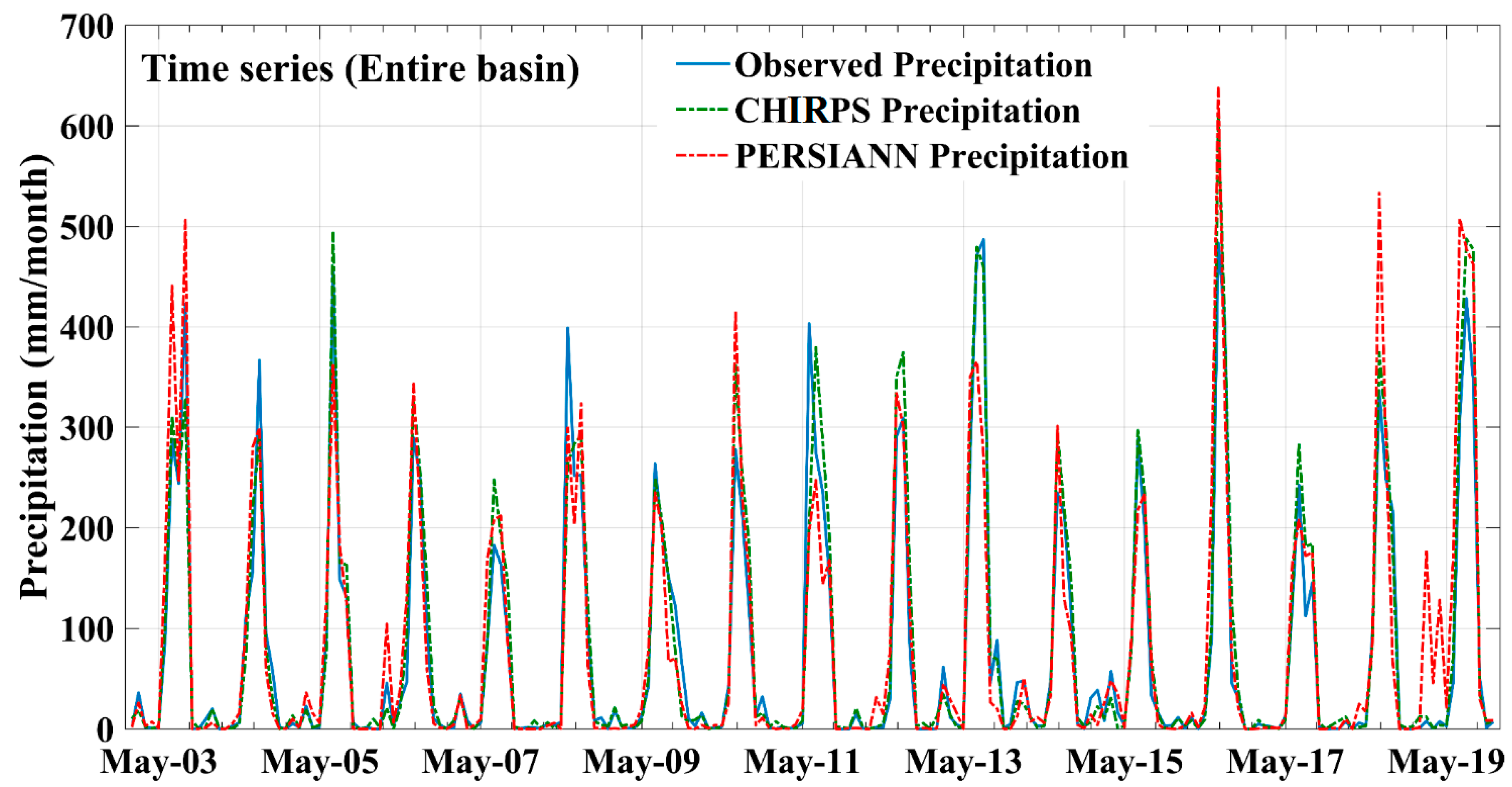

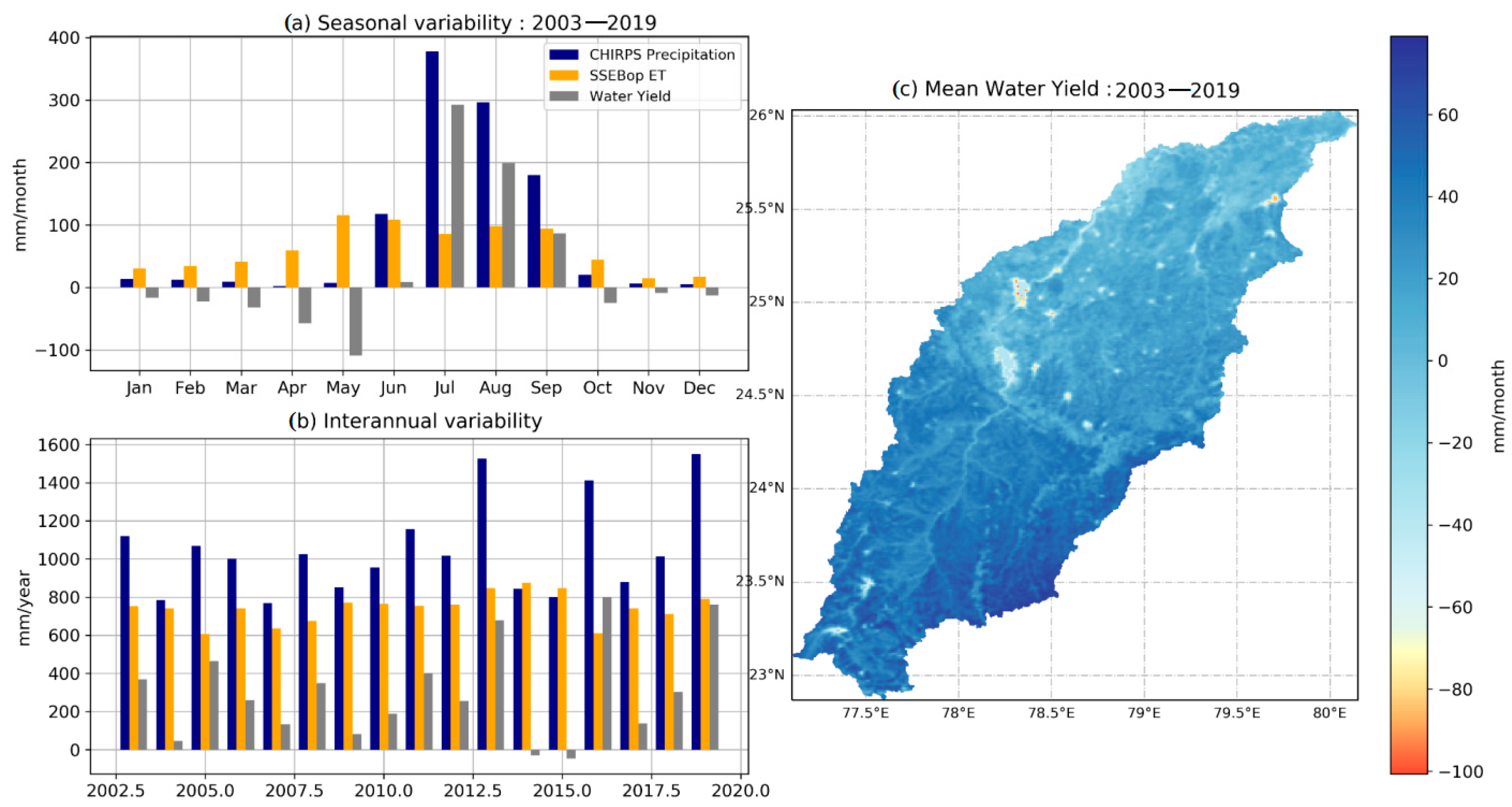

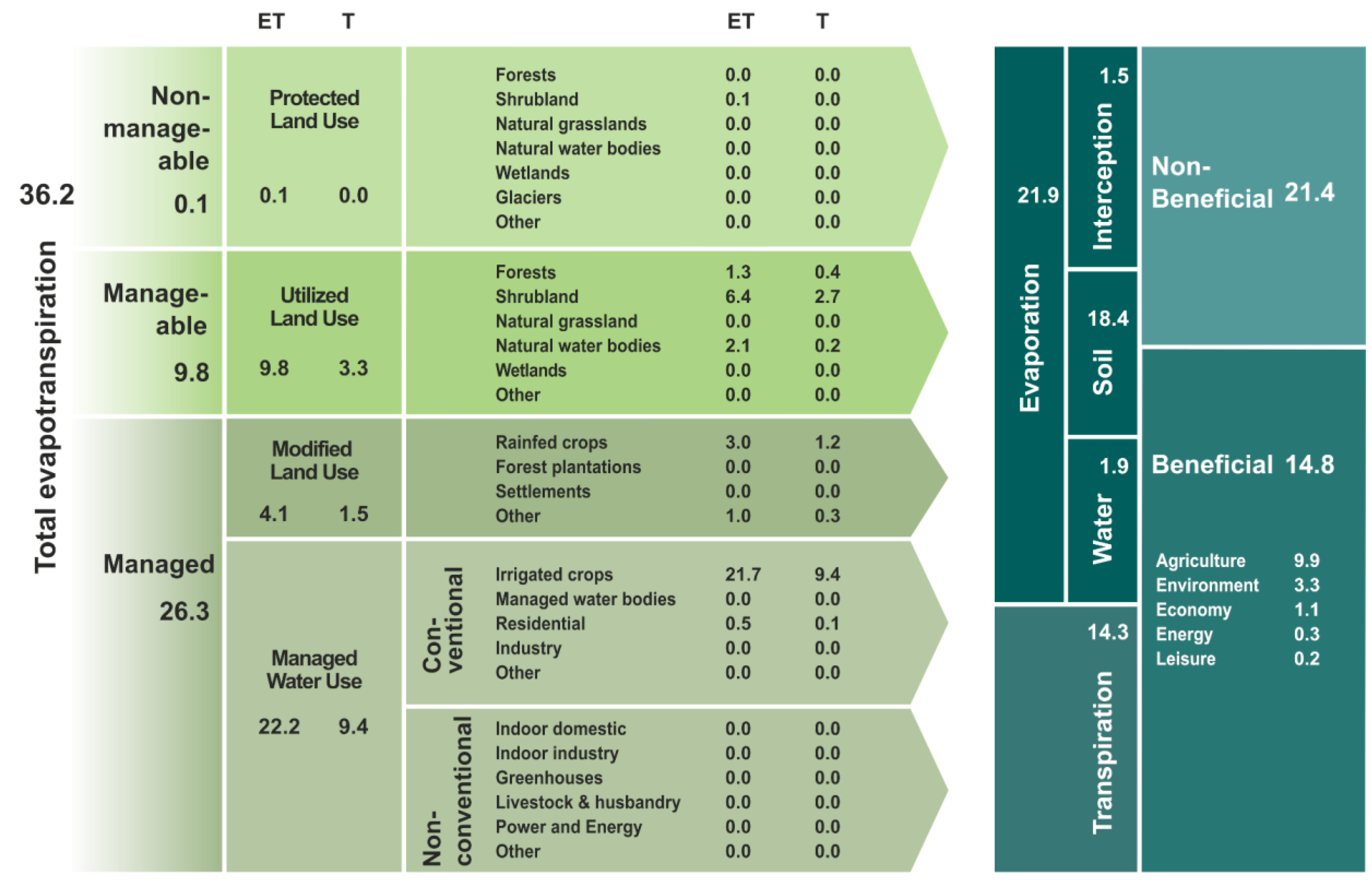
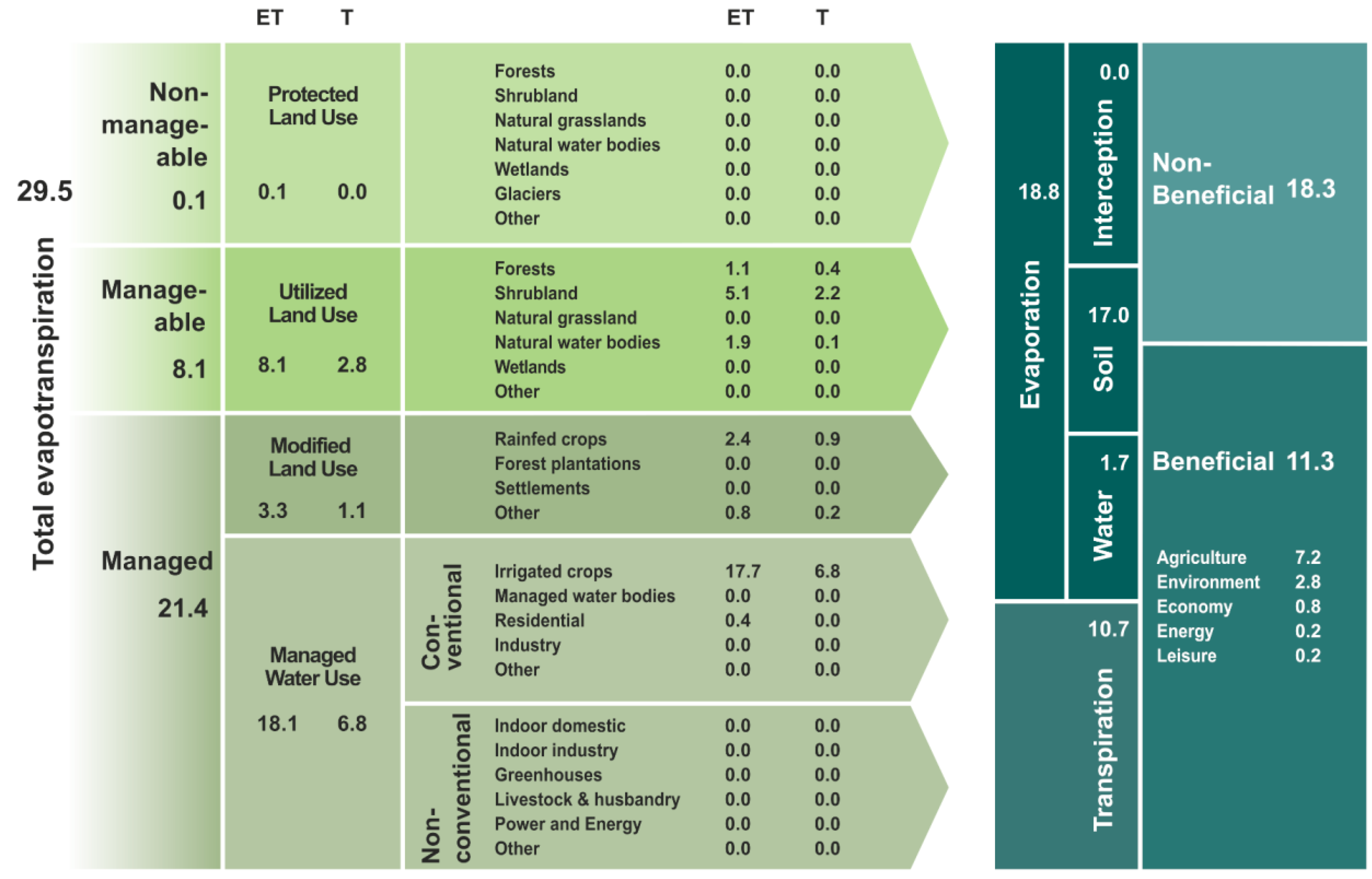
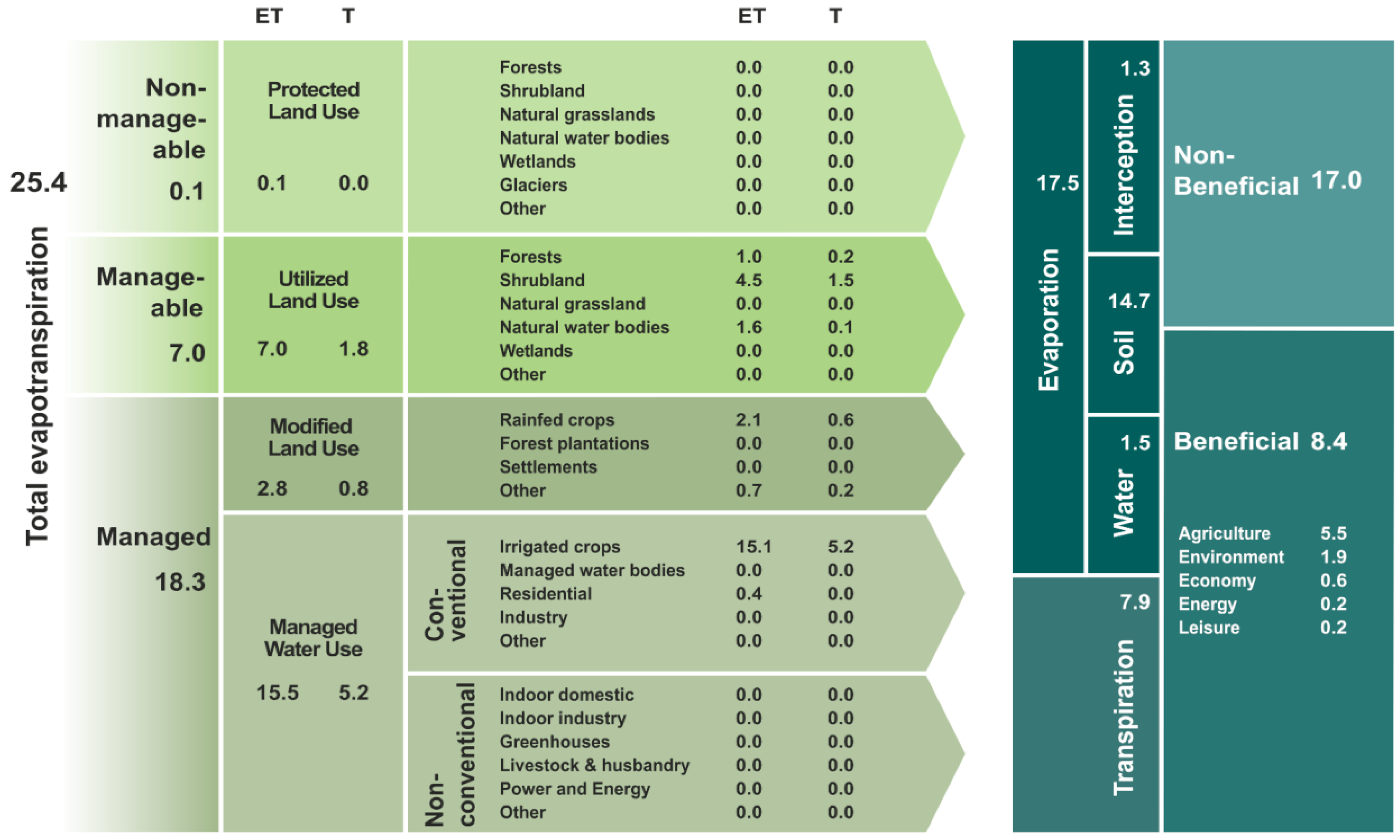

| Data Source | Data Types | Temporal Resolution | Spatial Resolution | Avilable from | Web Portal |
|---|---|---|---|---|---|
| WDPA | World data on protected areas | Annual | Shapefile | - | https://www.protectedplanet.net/en/thematic-areas/wdpa?tab=WDPA (accessed on 6 January 2022) |
| GlobCover LC v2 | Glob cover | Annual | 300 m | 1992–2015 | http://due.esrin.esa.int/page_globcover.php (accessed on 6 January 2022) |
| MODIS | Land use/land cover | Annual | 500 m | 2001-onwards | https://lpdaac.usgs.gov/products/mcd12q1v006/ (accessed on 6 January 2022) |
| MIRCA | Monthly irrigated and rainfed crop areas | Annual | 10 km | 1998–2002 | https://www.uni-frankfurt.de/45217893/5_MIRCA? (accessed on 6 January 2022) |
| GMIA | Global map of irrigated areas | Annual | 5 arc-min | 2013 | https://www.fao.org/aquastat/en/ (accessed on 7 January 2022) |
| 8daily LAI | Lead area index | 8 daily | 500 m | 2000 onwards | https://lpdaac.usgs.gov/products/mcd15a2hv006/ (accessed on 7 January 2022) |
| 8daily GPP | Gross primary production | 8 daily | 500 m | 2000 onwards | https://lpdaac.usgs.gov/products/mod17a2hv006/ (accessed on 7 January 2022) |
| Yearly NPP | Net primary production | Annual | 500 m | 2000-onwards | https://lpdaac.usgs.gov/products/mod17a3hv006/ (accessed on 7 January 2022) |
| IMD | Precipitation | Daily | 0.25° | 1901-onwards | https://www.imdpune.gov.in/ (accessed on 7 January 2022) |
| PERSIANN | Precipitation | Daily | 0.25° | 2000-onwards | https://chrsdata.eng.uci.edu/ (accessed on 7 January 2022) |
| CHIRPS | Precipitation | Daily | 5 km | 1981-onwards | https://www.chc.ucsb.edu/data/chirps (accessed on 7 January 2022) |
| Managed Water Use | Modified Land Use | Utilized Land Use | Conserved Land Use |
|---|---|---|---|
| Irrigated crops Irrigated pastures Irrigated biofuels Reservoirs and canals Irrigated fruit Greenhouses Aquaculture Residential areas and homesteads Industrial area Irrigated recreational parks Managed wetlands and swamps Inundation areas Mining Evaporation ponds Wastewater treatment beds Power plants | Plantation trees Rainfed pastures Rainfed crops cereals Rainfed fruit Rainfed biofuels Rainfed recreational parks Fallow land Dump sites Oasis and wadis Roads and lanes Peri-urban areas | Closed natural forests Tropical rain forest Open natural forest Woody savanna Open savanna Sparse savanna Shrub land Natural pastures Deserts Mountains Rocks Flood plains Tidal flats Bare land Wasteland Moore fields Wetlands and swamps Alien invasive species Permafrosts | Reserves or national parks Areas set aside for conservation Glaciers Coastal protection sites Protected forests Protected shrubland Protected natural water bodies Protected wetlands |
| Water Management Category (WMC) | WALU Code | WA+ Based LULC | Area (km2) | Area (%) |
|---|---|---|---|---|
| Protected Land Use (PLU) (20%) | PLU1 | Protected forests | 16.92 | 0.04 |
| PLU2 | Protected shrubland | 65.19 | 0.15 | |
| PLU3 | Protected natural waterbodies | 2.39 | 0.01 | |
| Utilized Land Use (ULU) (25.25%) | ULU1 | Closed deciduous forest | 1435.65 | 3.32 |
| ULU2 | Shrub land and mesquite | 7734.44 | 17.87 | |
| ULU3 | Brooks, rivers, and waterfalls | 1757.69 | 4.06 | |
| Modified Land Use (MLU) (11.10%) | MLU1 | Forest plantations | 0.57 | 0.00 |
| MLU2 | Rainfed crops—cereals | 3569.55 | 8.25 | |
| MLU3 | Rainfed crops—vegetables and melons | 17.26 | 0.04 | |
| MLU4 | Fallow and idle land | 1178.07 | 2.72 | |
| MLU5 | Rainfed industry parks—outdoor | 37.93 | 0.09 | |
| Managed Water Use (MWU) (63.46%) | MWU1 | Irrigated crops—cereals | 26,859.26 | 62.06 |
| MWU2 | Irrigated homesteads and gardens (urban cities)–outdoor | 211.54 | 0.49 | |
| MWU3 | Irrigated homesteads and gardens (rural cities)–outdoor | 349.06 | 0.91 | |
| Total Area (km2) | 43,280.54 | 100.00 | ||
| Datasets Used for Comparison | Locations | R2 | RMSE | NSE | BIAS (%) |
|---|---|---|---|---|---|
| Observed vs. PERSIANN | Basin Outlet | 0.79 | 44.09 | 0.45 | −46.6 |
| Observed vs. CHIRPS | 0.72 | 48.77 | 0.58 | −32.94 | |
| Observed vs. PERSIANN | Entire Basin | 0.83 | 48.35 | 0.81 | −6.75 |
| Observed vs. CHIRPS | 0.94 | 29.92 | 0.92 | −7.8 |
| Evaporation | For PERSIANN Precipitation | For CHIRPS Precipitation | Implication |
|---|---|---|---|
| Transpiration fraction | 36.27% | 36.27% | Sufficient amount of transpiration being generated from rainfed and irrigated areas |
| Beneficial fraction | 38.31% | 37.97% | Poor utilization of ET amounts |
| Agricultural ET fraction | 24.41% | 24.41% | Area dominated by agricultural activities |
| Irrigated ET fraction | 60.00% | 60.00% | Large proportion of ET came from irrigated areas |
| Rainfed ET Fraction | 8.14% | 8.14% | Considerable proportion of ET came from rainfed areas |
| Evaporation | For PERSIANN Precipitation | For CHIRPS Precipitation | Implication |
|---|---|---|---|
| Transpiration fraction | 39.50% | 31.10% | Sufficient amount of transpiration being generated from rainfed and irrigated areas |
| Beneficial fraction | 40.88% | 33.07% | Poor utilization of ET amounts |
| Agricultural ET fraction | 27.35% | 21.65% | Area dominated by agricultural activities |
| Irrigated ET fraction | 59.94% | 59.45% | Large proportion of ET being generated from irrigated areas |
| Rainfed ET Fraction | 8.29% | 8.27% | Considerable proportion of ET came from rainfed areas |
Publisher’s Note: MDPI stays neutral with regard to jurisdictional claims in published maps and institutional affiliations. |
© 2022 by the authors. Licensee MDPI, Basel, Switzerland. This article is an open access article distributed under the terms and conditions of the Creative Commons Attribution (CC BY) license (https://creativecommons.org/licenses/by/4.0/).
Share and Cite
Singh, V.G.; Singh, S.K.; Kumar, N.; Kumar, P.; Gupta, P.K.; Singh, P.K.; Gašparović, M.; Ray, R.L.; Saito, O. Water Accounting Using Satellite Products and Water Accounting Plus Framework in a Semi-Arid Betwa River Basin, India. Water 2022, 14, 3473. https://doi.org/10.3390/w14213473
Singh VG, Singh SK, Kumar N, Kumar P, Gupta PK, Singh PK, Gašparović M, Ray RL, Saito O. Water Accounting Using Satellite Products and Water Accounting Plus Framework in a Semi-Arid Betwa River Basin, India. Water. 2022; 14(21):3473. https://doi.org/10.3390/w14213473
Chicago/Turabian StyleSingh, Vikram Gaurav, Sudhir Kumar Singh, Nirmal Kumar, Pankaj Kumar, Praveen Kumar Gupta, Pushpendra Kumar Singh, Mateo Gašparović, Ram Lakhan Ray, and Osamu Saito. 2022. "Water Accounting Using Satellite Products and Water Accounting Plus Framework in a Semi-Arid Betwa River Basin, India" Water 14, no. 21: 3473. https://doi.org/10.3390/w14213473
APA StyleSingh, V. G., Singh, S. K., Kumar, N., Kumar, P., Gupta, P. K., Singh, P. K., Gašparović, M., Ray, R. L., & Saito, O. (2022). Water Accounting Using Satellite Products and Water Accounting Plus Framework in a Semi-Arid Betwa River Basin, India. Water, 14(21), 3473. https://doi.org/10.3390/w14213473










